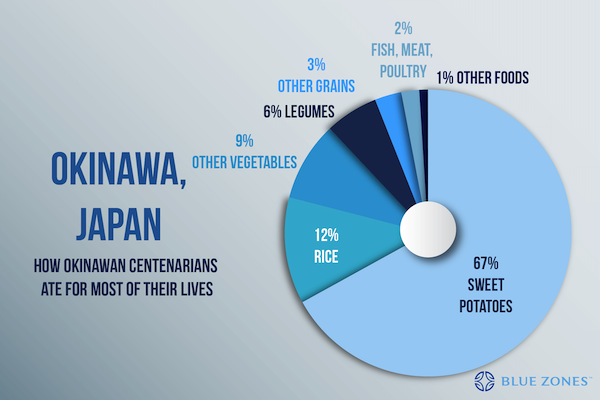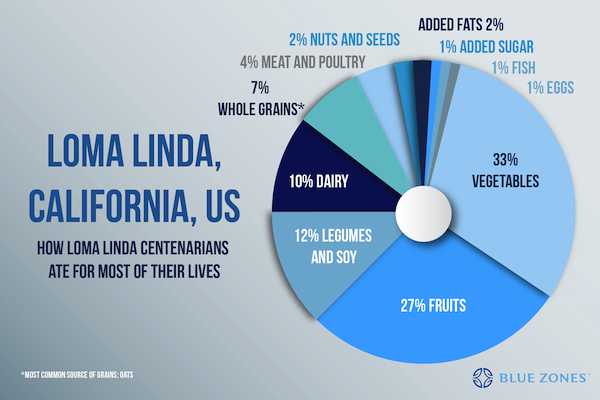The Protein Dilemma – What’s the Best Type and Amount to Eat?

Navigating the protein dilemma can be challenging. Let’s explore the debate between low and high protein intake for healthy aging, and plant vs. animal sources, especially as it relates to mTOR.

The protein dilemma is a complex and ongoing debate surrounding the ideal type and amount of protein to consume for optimal health and longevity. This topic has garnered significant attention from researchers, healthcare professionals, and individuals seeking to optimize their healthspan.
Here’s what I’m going to cover in this post:
- The low vs high protein consumption debate
- Plant vs animal protein through the mTOR lens
- The protein dilemma solution: Striking the right balance
- Your takeaway
Let’s dig in…
The Low vs. High Protein Consumption Debate
At the heart of the protein dilemma lies a fundamental question: Should we aim for a low or high protein intake as we age?
The US RDA for protein consumption is 0.8g per kg of body weight, but the majority of well-known “experts” I follow, such as Drs. Peter Attia, Gabrielle Lyon and Stuart Phillips, assert that 0.8 is too low, especially as the aging process diminishes protein muscle synthesis — the amount of protein that can be absorbed and utilized by skeletal muscle.
Is 0,8g per kg too low?
It depends:
- If you’re frail or consistently exercise with some vigor, it probably is too low, but
- If you don’t exercise, and not frail, it’s probably enough.
Having said that, if you eat meat and dairy products several times a week, you’re probably getting more than 0.8g/kg, unless you’re overweight, and in that case, does the part of your total body weight that’s represented by fat need to be fed protein? I think not.
OK, so now that we’ve established that 0.8 is the RDA recommendation, let’s go deeper to see if that’s the right mark for you, and what type of protein will serve you best.
The low-protein argument
Advocates of low-protein diets point to studies on long-lived animal species, such as naked mole rats and certain bird species, which thrive on relatively low-protein diets. These findings suggest that limiting protein intake may contribute to longevity by reducing the activation of the mechanistic target of rapamycin (mTOR) pathway, a cellular signaling pathway implicated in aging processes. (More about mTOR later.)
This theory finds support in human populations known for their exceptional longevity and low rates of age-related diseases, such as the inhabitants of Okinawa, Japan, and the Seventh-Day Adventist community in Loma Linda, California. The traditional Okinawan diet, rich in vegetables, legumes, and moderate amounts of fish, is relatively low in protein, with an estimated intake of around 9% of total calories from protein. Similarly, the plant-based diets of the Seventh-Day Adventists in Loma Linda are also relatively low in protein, with many adhering to lacto-ovo vegetarian or vegan diets.
I wrote about these two populations in my post, The Blue Zone Diet, which also included healthy, long-lived populations from three other so-called Blue Zones: Ikaria (Greece), Sardinia (Italy), and Nicoya Peninsula (Costa Rica).
The following two illustrations the Blue Zone diet post shows the mix of foods consumed by the residents of Okinawana and Loma Linda:


As you can see from the pie charts above, the mix of carbohydrates eaten by the Okinawans and Californians of Loma Linda, the proportion of the diet attributable to meat is 4% or less, although dairy, an animal-derived product, is 10% of the Loma Linda diet, whereas Okinawans traditionally eat no dairy.
Researchers have observed that populations from all the Blue Zones have lower rates of chronic diseases, such as cancer, heart disease, and diabetes, and enjoy longer average lifespans compared to their counterparts in Western countries. While genetics and other lifestyle factors may play a role, the low-protein, plant-dominant diets of these communities have been hypothesized as a contributing factor to their exceptional health and longevity.
Studies comparing vegan vs omnivore diets with resistance training typically find no significant differences in muscle mass and strength gains when total protein intake was matched at 1.6g protein per kg of body weight from supplemental soy (vegans) or whey (omnivores) protein.
This suggests that with adequate total protein intake, plant proteins can support muscle building during training periods; however, it’s undeniable that animal-sourced protein better stimulates muscle protein synthesis (protein uptake in skeletal muscles) around the exercise window. And that’s primarily because of two amino acids and one cellular signal:
- The amino acids are leucine and methionine; and
- The cellular signal is mTOR.
Now, in case you’re wondering, 1.6g/kg is a lot of protein to consume, especially if the source is plant-derived. I’m 209 lbs, or 95 kg (209 / 2.2). 95kg x 1.6g = 152 grams of protein per day — that’s an overwhelming amount to ingest from plant-derived proteins.
The best I can regularly do when relying on plant protein sources, which includes two smoothies, is 110 grams per day, and yet, I don’t suffer from the lack of muscle. Of course, 110 grams of protein per day — along with a bewildering amount of weightlifting — is not going to make me a successful bodybuilder, but that’s not the objective.
The objective is to “live long and strong”, and the “strong” part of that statement doesn’t require you to bench press twice your body weight, or consume 1.6g/kg of protein, plant based or otherwise, perhaps unless you’re frail and underweight, and need to quickly rehabilitate.
The high protein argument
Proponents of higher protein consumption argue that maintaining adequate protein intake is crucial for preserving muscle mass and strength as we age, thereby combating sarcopenia (age-related muscle and strength loss). They cite research indicating that older adults may require higher levels of protein, ranging from 1.0 to 1.2 grams per kilogram of body weight, or more, to support muscle health and function.
It’s clearly true that animal proteins tend to be more beneficial than plant proteins for increasing lean mass, especially in younger adults [1]. This is likely due to their higher quality and better amino acid profile, including higher leucine and methionine content, key stimulators of muscle protein synthesis.
A systematic review and meta-analysis found that while protein source did not affect changes in absolute lean mass or muscle strength, there was a favoring effect of animal protein on percent lean mass compared to plant protein [2].
Younger adults (<50 years) were found to gain more absolute and percent lean mass with animal protein intake compared to plant protein [3].
What you need to ask yourself is, Do I need more protein?
If you’re frail or exercise a lot, perhaps you do. But don’t automatically assume that more protein is always better. You need to consider the protein source and what it does to mTOR.
Plant vs Animal Protein Through the mTOR Lens

Another aspect of the protein dilemma revolves around the source of protein. We’ve touched on this a bit above, but here I want to introduce a spin on the topic that is rarely addressed — mTOR.
Plant-based proteins, such as those found in legumes, whole grains, nuts, and seeds, are generally lower in the essential amino acids leucine and methionine. Conversely, animal proteins, particularly those from dairy and meat sources, are typically higher in leucine, methionine and other amino acids that can upregulate mTOR (mechanistic target of rapamycin).
Leucine, methionine are potent activators of the mTOR pathway.
mTOR is a crucial cellular signaling pathway that plays a central role in regulating various processes related to growth, proliferation, and metabolism. It acts as a nutrient sensor, responding to factors such as amino acids, growth factors, and energy status, and orchestrating cellular responses accordingly.
Connection to the Hallmarks of Aging
mTOR has been implicated in several of the Hallmarks of Aging, as defined by researchers in the field of aging biology.
Four of these Hallmarks, at minimum, are tied to mTOR:
- Genomic instability: Upregulated mTOR can promote cell growth and division, increasing the risk of acquiring genomic mutations and chromosomal abnormalities.
- Cellular senescence: mTOR activation has been linked to the induction of cellular senescence, a state of permanent cell cycle arrest that can contribute to tissue dysfunction and inflammation.
- Stem cell exhaustion: Chronic mTOR activation can lead to the depletion of stem cell pools, impairing tissue regeneration and repair mechanisms.
- Altered intercellular communication: mTOR signaling influences the secretion of various signaling molecules, potentially disrupting the communication between cells and contributing to age-related tissue dysfunction.
(Read my post, The New Hallmarks of Aging — Why You Age.)
The Dual Role of mTOR
During early life and development, mTOR plays a crucial anabolic role, promoting growth and tissue maintenance. This function is beneficial for supporting the growth and maturation of the body. But there’s a downside: as we age, the persistent activation of mTOR can have detrimental consequences.
This reminds me of the old adage:
The candle that burns twice as bright burns half as long.
Numerous animal studies have shed light on the impact of mTOR signaling on healthspan and lifespan. Here are a few examples:
- Calorie restriction: Calorie restriction, a dietary regimen that involves reducing caloric intake while maintaining adequate nutrition, has been shown to extend lifespan in various animal models, including mice, rats, and primates. One of the proposed mechanisms behind this effect is the downregulation of mTOR signaling, which reduces cellular growth and proliferation, thereby mitigating age-related damage.
- Rapamycin treatment: Rapamycin, a potent mTOR inhibitor, has been extensively studied in animal models. Mice treated with rapamycin exhibited extended lifespan and delayed onset of age-related diseases, such as cancer and Alzheimer’s disease. These findings suggest that inhibiting mTOR can have protective effects against aging processes. (Read my post, Can You Age Better with Rapamycin?)
- Genetic manipulation: Researchers have genetically manipulated components of the mTOR pathway in various animal models, such as fruit flies, nematodes, and mice. In several instances, downregulating mTOR signaling or its upstream activators resulted in increased lifespan and improved healthspan, further reinforcing the connection between mTOR inhibition and longevity.
It’s important to note that while the animal studies provide valuable insights, translating these findings to human biology and aging is complex, and further research is needed to fully understand the implications of mTOR modulation in humans.
Personally, I’m not waiting for this “full” understanding, because there seems to be a safe way to pulse, or modulate, the right types of protein at the right times to gain the anabolic effects of mTOR when needed, while not activating it when not.
Why bother?
Because the emerging evidence suggests that while mTOR activation is essential for growth and development, chronic upregulation of this pathway may contribute to the accumulation of cellular damage and the development of age-related diseases.
Strategies aimed at modulating mTOR activity, such as calorie restriction or targeted interventions, hold promise for promoting healthy aging and extending healthspan, but a balanced approach is crucial to maintain optimal physiological function.
Proponents of plant-based proteins argue that consuming a greater proportion of protein from plant sources may help reduce chronic mTOR over stimulation, potentially mitigating the risk of age-related diseases associated with excessive mTOR activation. However, advocates of animal proteins highlight their superior bioavailability and complete amino acid profiles, which may be more beneficial for maintaining muscle mass and strength, particularly in older adults.
The key is to find the right balance, and that’s what I’ll address next
The Protein Dilemma Solution: Striking the Right Balance

What I do is to strategically time the intake of leucine-rich and plant-based proteins to strike a beneficial balance between promoting muscle anabolism when needed after resistance training (weightlifting or calisthenics) and limiting chronic mTOR activation on non-training days.
This is a “periodized” approach to mTOR modulation, which involves cycling between periods of mTOR stimulation and inhibition.
According to this approach, consuming leucine and methionine-rich protein sources, such as whey, meat, and dairy, immediately after resistance training or during periods of muscle recovery, can provide the necessary amino acid stimulus to activate mTOR and promote muscle protein synthesis. This strategic timing allows for the desired anabolic response when the body requires it most. (Note: I rarely eat meat, so my post-resistance workout protein sources are whey, casein and occasionally kefir and yogurt.)
However, during non-exercise periods or when muscle anabolism is not a primary concern, I consume plant-based protein sources with lower leucine and methionine content, such as legumes, grains, and certain plant-based protein powders (e.g., pea, rice, or soy). These sources are less likely to strongly activate mTOR, potentially mitigating the risk of chronic mTOR over stimulation and its associated negative effects on aging and longevity.
This “pulsatile” approach to mTOR modulation is also supported by other experts in the field, including Dr. Valter Longo, a prominent researcher in the field of aging and fasting. In his book The Longevity Diet, Longo recommends a similar strategy of consuming animal-based proteins and leucine-rich sources around resistance training sessions, while relying more heavily on plant-based proteins during non-exercise periods.
Furthermore, a review article published in the The American Journal of Clinical Nutrition highlights the potential benefits of this periodized approach, suggesting that intermittent mTOR stimulation through leucine-rich protein intake may be advantageous for maintaining muscle mass and function, while limiting chronic mTOR activation through periods of plant-based protein consumption could mitigate the negative consequences associated with sustained mTOR upregulation.
The article concludes:
Skeletal muscle responds to a leucine-rich meal by initiating the energy-expensive process of muscle protein synthesis, and simultaneously leucine stimulates pathways that increase energy expenditure…These findings suggest that intermittent leucine-rich meals may be advantageous for stimulating muscle protein synthesis and increasing energy expenditure, while periods of lower leucine intake may allow energy conservation.
It’s important to note that while this periodized approach is gaining traction among researchers and experts, individual factors such as age, activity level, and overall health status should be considered when determining the optimal protein sources and timing.
Ultimately, the protein dilemma serves as a reminder that the path to optimal health and longevity is multifaceted, and finding the right balance of protein type and amount is a crucial aspect of this journey.
Your Takeaway
Remember these four things so you can reconcile your protein dilemma:
- You need to assess how much protein to consume based on your physical condition. If you’re frail, or exercise regularly (especially resistance training) you might need to consume more protein than the recommended RDA of 0.8g/kg. If you eat animal product regularly and don’t exercise, you’re probably getting enough, even if it’s “only” 0.8.
- Eating an animal-dominant diet (regularly consuming meat and dairy) is likely to chronically keep mTOR upregulated (activated). In all animal mTOR studies, mTOR reduces healthspan, and in some cases, lifespan.
- If you’re committed to animal-derived products, eat less of them less often. Instead, eat more plant foods like legumes (lentils and beans), veggies, greens, nuts and seeds (hemp, flax, chia).
- If you exercise and eat animal products, eat them on exercise days, given that the leucine and methionine amino acids in animal-derived foods will activate mTOR, and thereby improve muscle protein synthesis. A whey-based smoothie is a good way to go.
That’s it… if you have any comments, scroll down and have at it. And if you know anyone who could benefit from this post, send it!
Last Updated on June 8, 2024 by Joe Garma


